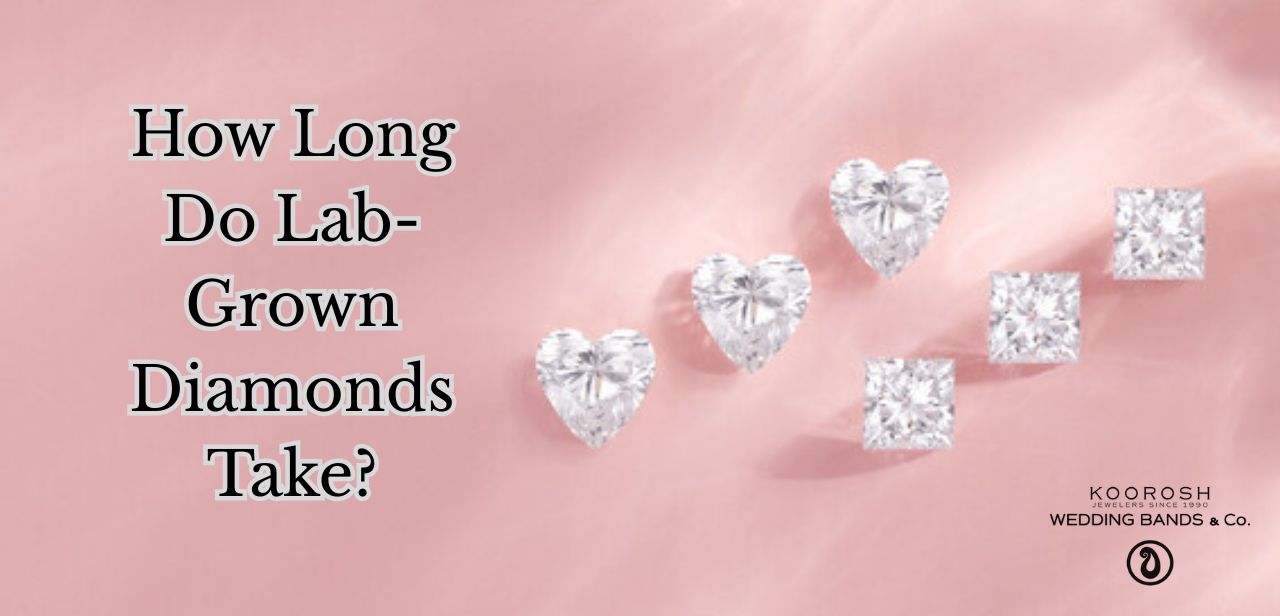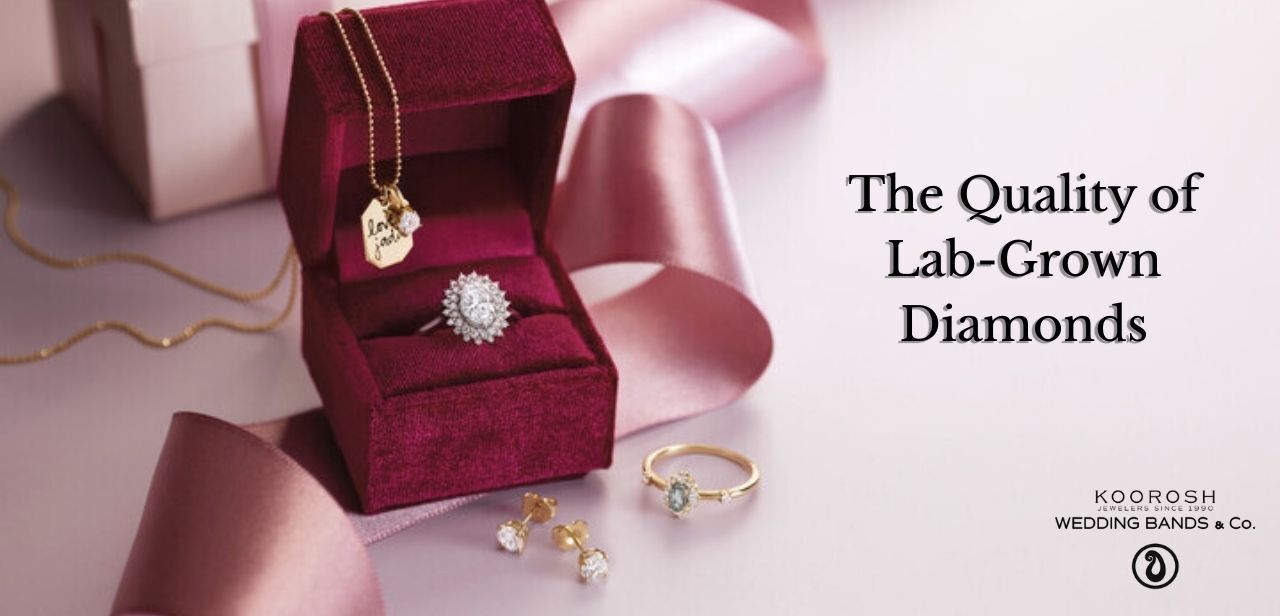How Long Do Lab-Grown Diamonds Take?
Posted by Koorosh Daneshgar on Jan 15th 2023

Understanding Ring Structure: The Timeframe for Lab-Grown Diamond Growth
The first thing most people think about when they envision an ideal engagement ring is. At Wedding Band & Co. we serve many Chicago couples who begin their selection process with the center stone which is the diamond. But not just any diamond. Many contemporary couples now choose lab-grown diamonds for their ethical origins and their natural diamond appearance and budget-friendly price. At Wedding Band & Co. our clients frequently ask us this question:
“Just how much time does it require to make a lab-grown diamond?”
To answer that, we’re taking a deep dive into the anatomy of a ring, focusing on the heart of it all: the center stone, and how long it takes for a lab-grown diamond to become the focal point of your dream ring.
The Heart of the Ring: What Is a Lab-Grown Diamond?
A ring contains its center stone as its heart which serves as both an expression of love and personal uniqueness. A lab-grown diamond maintains the identical chemical and visual structure of natural diamonds but scientists create these stones through laboratory methods above the ground with modern technology. Real diamonds that use the 4Cs grading system for cut, color, clarity, and carat are produced through this process.
At Wedding Band & Co., our Chicago location offers custom engagement ring design services with both lab-grown and natural diamond options to let couples personalize their preferences regarding style and budget and values.

The Science of Creation: How Lab-Grown Diamonds Are Made
2 different techniques exist to create diamonds inside laboratory settings.
1. HPHT – High Pressure, High Temperature
The method duplicates the natural process by which diamonds are created deep beneath the Earth. A small diamond seed experiences both massive pressure exceeding 1.5 million PSI and scorching heat exceeding 2,000°F. The carbon atoms construct a larger diamond through time while encircling the seed.
Timeline: The time needed to produce HPHT diamonds ranges from four weeks to twelve weeks based on diamond size and clarity level.
2. CVD – Chemical Vapor Deposition
A vacuum chamber containing carbon-rich gas receives a diamond seed which gets placed inside. The heated gas breaks free of carbon atoms which then descend to create diamond layers on the seed.
Timeline: The production time for CVD techniques allows fast and efficient diamond creation which produces premium stones between two and four weeks for small stones while larger stones need eight to ten weeks.

Precision in Growth: Why Quality Takes Time
Similar to the process of ring band and setting and prong creation, making lab diamonds requires extreme precision. The final quality of a diamond depends on gas purity as well as temperature stability and growth duration. The precise monitoring of conditions allows diamonds to develop free from impurities as well as defects.
After the growth process, the rough diamond requires additional processing before it can be installed in a ring. The cutting and polishing stage applies to both mined diamonds and follows the process. The gem cutters who possess specialized expertise transform the stone by creating its facets to maximize both brilliance and fire.
The Grading Process: Ensuring Diamond Integrity
Every polished lab-grown diamond receives grading evaluation at IGI or GIA facilities where it meets the exact grading criteria for natural diamonds. The grading assesses:
- Cut – How well the diamond’s facets reflect light
- Color – The absence of color (graded D to Z)
- Clarity – The number and type of internal flaws
- Carat Weight – The size and weight of the diamond
The length of time required for grading depends on the certifying laboratory as well as the quantity of diamonds being evaluated and typically ranges from 3-7 days.
A single lab-grown diamond requires 3 weeks to 3 months of time for completion especially when choosing large carat weights or top-tier clarity ratings.
Lab-Grown Diamonds Represent the Preferred Choice Among Chicago Couples
The number of Chicago couples choosing lab-grown diamonds for their engagement rings continues to rise because of these specific advantages.
1. Ethical Sourcing
Lab-grown diamonds maintain absolute ethical compliance while being free from conflict zones and human rights violations. The peace-of-mind that lab-grown stones provide makes them an ideal selection for Chicago couples who want to create custom engagement rings.
2. Environmental Responsibility
Traditional diamond mining leads to environmental damage through forest removal and water pollution and habitat destruction. Lab-grown diamonds exist through controlled laboratory production which minimizes environmental damage.
3. Affordability
The price of lab-grown diamonds sits between 30% to 50% below natural diamond prices of similar quality thus enabling couples to spend more on band design or setting features or select larger stones.

The Final Anatomy: Pairing Your Diamond with the Perfect Setting
After your lab-grown diamond reaches completion you must choose a suitable ring setting. At Wedding Band & Co., we view this stage as the essential final step in creating a ring.
Chicago clients favor the following setting styles when shopping for their rings:
- Solitaire – This design presents a single lab-grown diamond with simplicity and elegance for maximum focus on the stone
- Halo – A sparkling frame of smaller diamonds that enhances the size of the center stone
- Pavé or Micro-pavé – Tiny diamonds encrusted into the band for a luxurious finish
- Three-stone – Symbolizing the past, present, and future of your relationship
- Custom Mixed Metal Bands – White gold and rose gold are trendy metal combinations used to create modern ring designs
From Lab to Love Story: Real Chicago Couples, Real Results
The team at Wedding Band & Co. assists hundreds of Chicago couples in Lincoln Park, West Loop, Gold Coast and more to discover their ideal lab-grown diamond rings. Our in-house design team with master jeweler Koorosh Daneshgar leads you through the process of creating modern engagement rings with lab-grown diamonds or matching custom wedding bands.
Our clients frequently share their appreciation for:
- Transparent timelines (no hidden wait times)
- Personalized consultation and 3D design previews
- A wide selection of lab-grown and natural diamonds to compare
Final Verdict: How Long Do Lab-Grown Diamonds Take?
To recap:
- CVD method: 2–10 weeks depending on size
- HPHT method: 4–12 weeks for larger stones
- Grading and certification: Add another 1 week
- Total time: Anywhere from 3 weeks to 3 months
The extended period of time until your diamond is ready should be viewed as the process of creating your permanent ring.
No aspect of a ring holds greater importance than the stone that represents your relationship story.

Design Your Custom Lab-Grown Diamond Ring in Chicago
Are you prepared to turn your dream into reality? Wedding Band & Co. provides services for customers in Chicago who need eco-friendly engagement rings and budget-friendly custom designs along with unique lab-grown diamond rings.
Contact us to book your free consultation which includes full support for diamond selection and ring design at our Chicago location.
Your love is one of a kind. Your ring should be too.
Visit us:
Wedding Band & Co.
43 E Oak St, Second Floor, Chicago, IL 60611
+13129200726

By: Koorosh Daneshgar CEO/Design Chief
We'll help you to design your dream engagement ring without stress and spending countless hours searching for your perfect ring. All you need to do is click on "Free Consultation" to get started.

